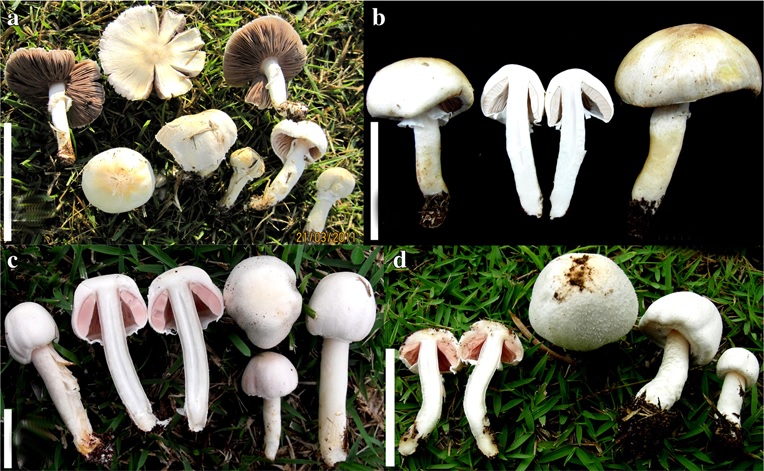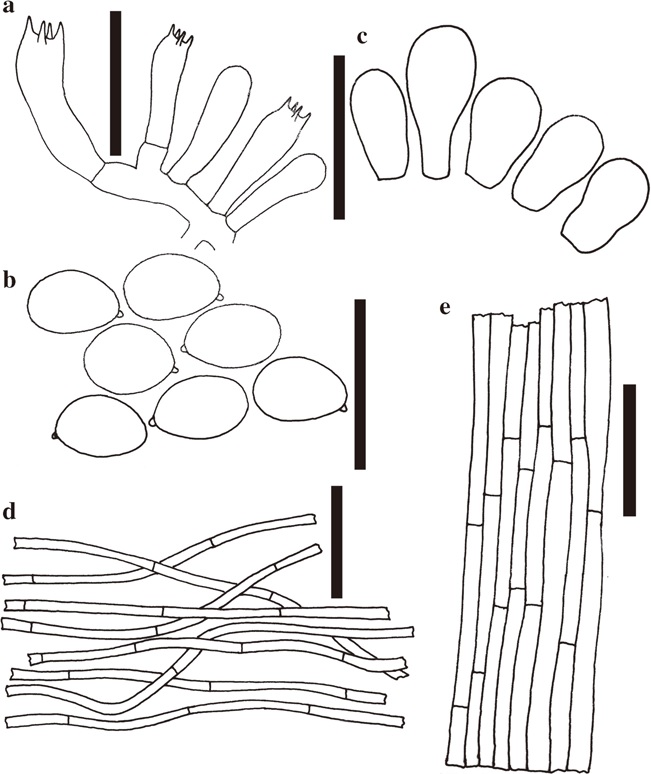Agaricus flavicentrus Karunarathna & K.D. Hyde
Index Fungorum number: IF550891 Facesoffungi number: FoF 00392
Etymology: flavicentrus, in reference to the “yellow centre”, which is the colour of the pileus centre of this new species.
Holotypus: MFLU 12–0146 Pileus 30–70 mm diam., circular from above, hemisphaerical when young, convex when old; pileus splits when matured, surface dry, smooth, with small yellow flakes on the centre, yellowish white (2A2) at the centre white (5A1) towards the margin when young and old; no colour changes on pileus and stipe surfaces. Context in pileus 3–5mmthick at the disc, fragile, white, soft, and colour unchangeable. Lamellae free, crowded with 4 tiers of lamellulae, 2–3 mm wide with homomorph edge, light brown (5D4) at first, then dark brown to chocolate brown (6F) at maturity, with concolourous even edge. Annulus is simple, single, fragile, no floccose pieces, 10 mm diam., pendent, stretched, white, cottony, white to slight yellowish white (3A2). Stipe 40–70×10 mm at the base, at the middle, and at the top, cylindrical, centrally attached to pileus, buried, fistulose; context white, cottony; surface smooth, slight yellowish white (2A2) at the top and yellowish white (3A2) at base; rhizomorphs absent at base. No discolouration observed in the pileus or stipe context on touching or cutting. Odour bitter almond-like. Basidiospores 10–11× 6–7 μm (x=10.50×6.50 μm, Q=1.75–2.12, Qm =1.97, n=40), mostly oblong but rarely ellipsoid, without germ pore, smooth, chocolate-brown in mass, thick-walled. Basidia 18–25×4–6.5 (–7) μm, clavate, 4-spored. Cheilocystidia 12–18×8–10μm, broadly clavate, single, hyaline, smooth. Pleurocystidia absent. Pileipellis a cutis; hyphae 2.5–3μm diam., inflated, hyaline, unbranched. Stipitipellis hyphae similar to pileipellis hyphae 1.5–2μm diam. Clamp connections absent.
Macrochemical reaction: no reaction with 5 % KOH on pileus surface and stipe surface (negative). Negative results obtained for the Schaeffer reaction on fresh context of pileus and stipe base.
Habitat: as a group on grassland with humus-rich, organic matter rich soil. Fruiting at the beginning of the rainy season, found in open grassland with lot of organic litter mixed soil.
Material examined: THAILAND, Chiang Rai Province, Mueang Chiang Rai District, Mae Fah Luang University park, 20° 2′44.39″N 99°53′37.38″E, 258 m, 21 March 2011, S.C. Karunarathna (MFLU12–0146, holotype); GenBank ITS: KR025857. THAILAND, Chiang Mai Province, Mueang Chiang Mai District, Chiang Mai University park, 18°48′22″ N 98°57′10″E, 345 m, 27 July 2011, S.C. Karunarathna (MFLU12–0147); GenBank ITS: KR025854. THAILAND, Chiang Rai Province, Mueang Chiang Rai District, Mae Fah Luang University park, 20° 2′44.39″N 99°53′37.38″E, 258 m, 23 March 2011, 15 May 2013, S.C. Karunarathna (MFLU12–0148; GenBank ITS: KR025855; MFLU12–0149; GenBank ITS: KR025856).
Notes: This new species is distinguished by its relatively small to moderate basidiomes with a soft, hemisphaerical and yellowish centered pileus; 10–11×6–7μm sized mostly oblong, thick-walled basidiospores, well visible single, nonfloccose, fragile, annulus; 12–18×8–10μm, broadly clavate cheilocystidia and pleasant bitter almond odour.
Read more: http://link.springer.com/article/10.1007/s13225-015-0324-y



